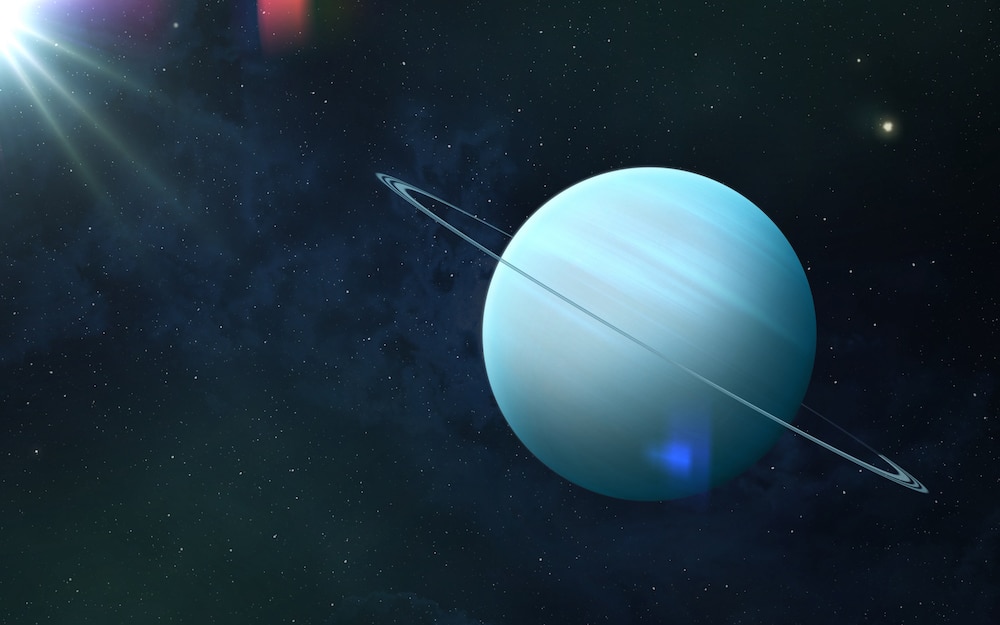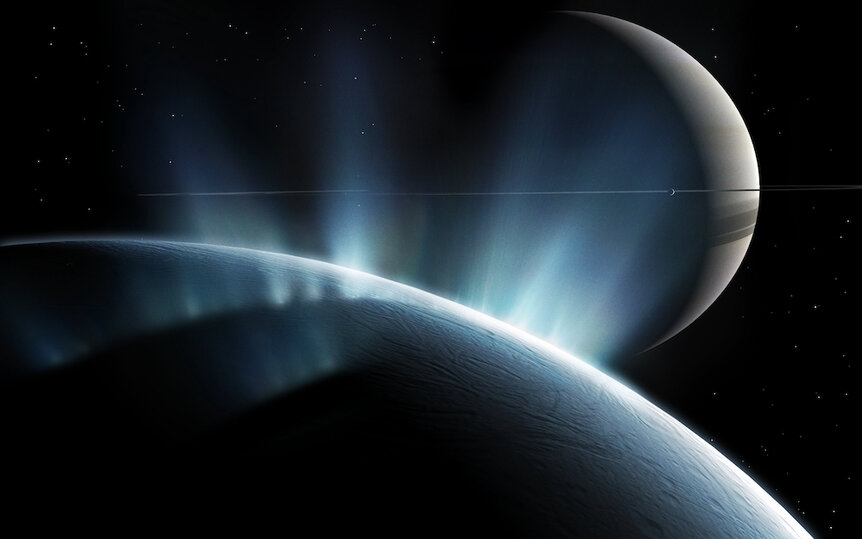Create a free profile to get unlimited access to exclusive videos, sweepstakes, and more!
It’s about time we plan a mission to Uranus — and seek out aliens on Enceladus
Watch out, Mars. Uranus and Enceladus might be coming for your headlines.

While Mars continues making headlines, nothing has ever seen Uranus up close or probed Enceladus for signs of life, but they are about to be in the cosmic spotlight.
Nothing has visited Uranus since the Voyager 2 flyby in 1986. Anything else we know about this secretive ice giant comes from Hubble and a few telescopes on terra firma. Saturn's moon Enceladus had been eyed by Cassini, and plumes of water vapor gave Earthlings a glimpse of what might be an ocean world swarming with life beneath all that ice, but it was not explored nearly enough. Now that the third decadal survey (which recommends potential missions every decade) has made them a priority, we could see something taking off in the future.
Uranus is a bluish orb of mystery. Methane gives it its eerie color, and hydrogen and helium are also in its atmosphere, which swirls above a core of iron and magnesium silicate. There are still many unknowns hiding where we haven’t yet probed them. Enceladus could be crawling with life-forms. This water world could be the frozen version of Hyneria from Farscape, but even if hypothetical aliens in its fathomless depths aren’t nearly as intelligent as Rygel, who swears he knows frelling everything, it would change our ideas about what can survive out there.
Origins, Worlds and Life is the third decadal survey ever. Published by the U.S. National Research Council (NRC), this compilation includes 522 reports from NASA-affiliated universities and research institutes from all over the planet, including Southwest Research Institute (SwRI), CalTech, the Planetary Science Institute (PSI), Arizona State University, and Johns Hopkins University. A recent briefing led by scientists on the NASEM (National Academies of Sciences, Engineering, and Medicine) committee highlighted priorities, strategies, and questions.
Planetary scientist Robin Canup, the assistant vice president of the Planetary Sciences Directorate at the Southwest Research Institute, is the decadal survey committee steering committee co-chair.
“A mission to one of the ice giant planets was judged to be the top priority, primarily for its ability to produce transformative, breakthrough science,” she told SYFY WIRE. "Conditions at Enceladus are thus ideal to allow for direct investigation of the habitability of an ocean world and assessment of whether or not it is inhabited."
Factors taken under consideration for missions proposed in the decadal survey included their potential to make scientific breakthroughs (obviously), technical risk, programming, cost (unfortunately), and viability of actually launching any of these missions within the next decade. Those that ultimately made it to the top could answer some of our most pressing questions.
Highest priority goes to Uranus. The Uranus Orbiter and Probe (UOP) is the proposed mission that will, if NASA decides to take it on, orbit the planet for years to find out more about what goes on its its atmosphere, magnetic field, and interior. It could possibly answer the question of whether its strange tilt, and possibly its rings and moons, arose in the aftermath of a massive impact billions of years ago. This is one reason Canup wants to probe it up close. Uranus also has 27 known moons. Voyager 2 was able to tell that some of these hunks of ice and rock were geologically active — maybe there are cryovolcanoes.
"Uranus has a very bizarre system," she said. "It orbits essentially on its side, with a north pole that lies nearly in the plane of its orbit around the Sun, yet its rings and satellites orbit neatly within its equatorial plane," she said. "How the system obtained this state is unclear."
Neither Uranus or Neptune has ever had a dedicated mission, which is why these ice giants are such an enigma. The irony is that ice giants are extremely common in the universe. Anything learned from Uranus could potentially tell us about similar alien planets and how they and their star systems formed. Neptune is somewhere on the list. The reason Uranus was prioritized was because UOP was more technically ready, with a mission connect that would work out, which could use launch vehicles that already exist, and its trajectory would also allow it to launch earlier than the Neptune mission that was debated. UOP could be taking off for Uranus as soon as 2031.
Right behind UOP is the Eneceladus Orbilander mission. The plumes that Cassini caught spewing water vapor into space mean there is probably liquid water beneath its miles of ice, much like Europa’s. There might be hydrothermal vents somewhere within Enceladus. If there are, and they are anything like those at the bottom of the ocean on Earth, which are swarming with microbes, there is a possibility of life as we know it. Getting a much closer look at what is gushing out of those plumes will be the only way to find out whether Saturn’s icy moon is even habitable.
"Life detection is not an easy task," said Canup."Since we do not have a general theory of life or even a universally accepted definition of what constitutes a living system, the best we can do is to look for evidence of the general characteristics of biological systems."
Orbilander would use five different techniques to try and identify life, as least as we know it, though there is always the possibility that if any ice exists beneath the surface of Enceladus, it might be life as we never knew it. There is no instrument that can definitely tell us whether there is life on another body. There could be one giveaway, though. When abiotic systems produce organic compounds, such as lipids and amino acids, they often end up making just about every possible type. Actual organisms are much more selective with what they put out. Every one of the Orbilander techniques would investigate the plumes spouting from vents in the moon's south pole, and the spacecraft would make several passes, because who knows if alien microbes might be injected into space.
"Enceladus addresses one of the most fundamental questions in solar system science," said Canup. "Is there life beyond Earth and if not, why not?"
But first, Mars. While UOP and Orbilander won’t be launching until the 2030s if approved, the Mars Sample Return Mission should be heading to the Red Planet in 2026. Whatever Perseverance collects should land on Earth several years from then.
The briefing was live-streamed for all citizens of Earth. You can watch it here.



























